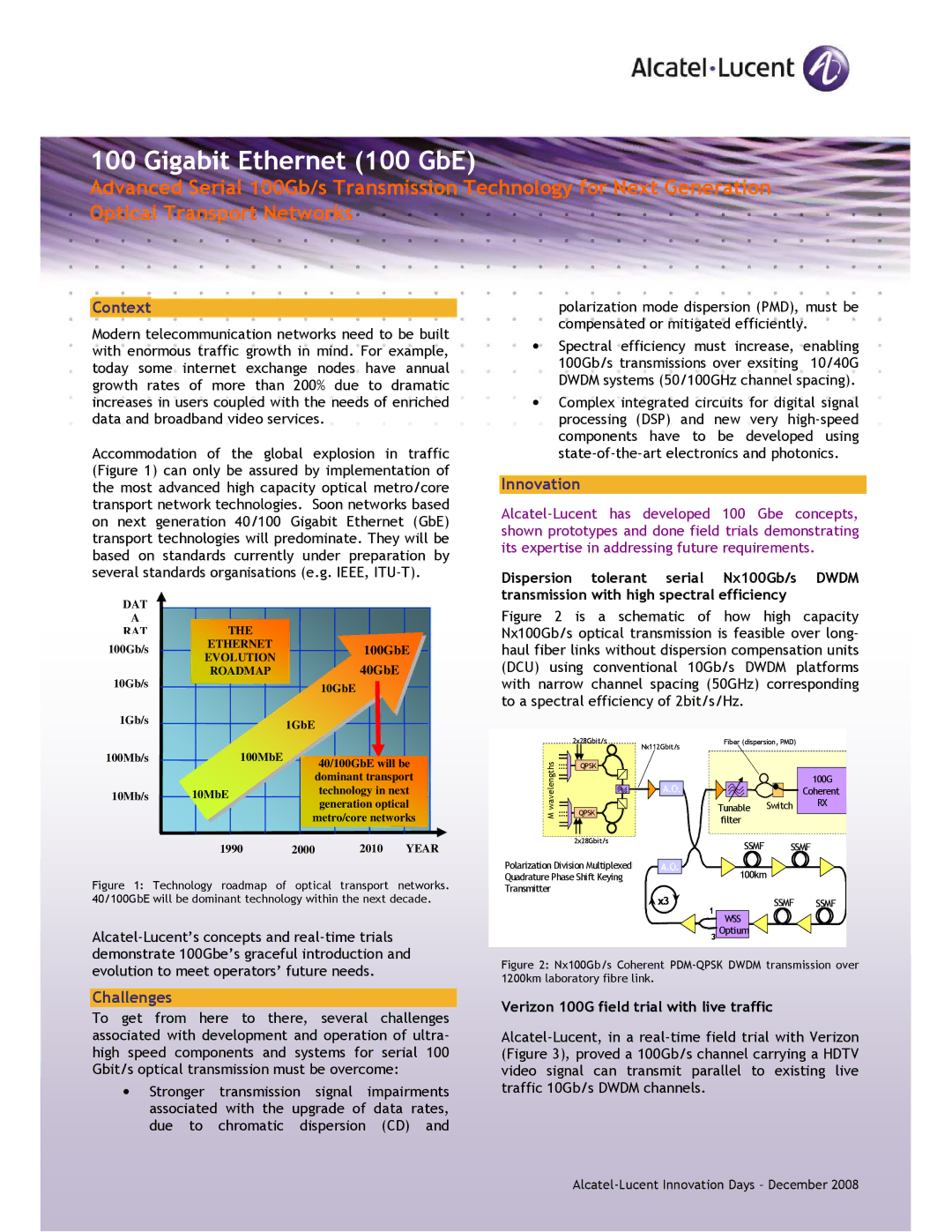
100 Gigabit Ethernet (100 GbE)
Advanced Serial 100Gb/s Transmission Technology for Next Generation Optical Transport Networks
Context
Modern telecommunication networks need to be built with enormous traffic growth in mind. For example, today some internet exchange nodes have annual growth rates of more than 200% due to dramatic increases in users coupled with the needs of enriched data and broadband video services.
Accommodation of the global explosion in traffic (Figure 1) can only be assured by implementation of the most advanced high capacity optical metro/core transport network technologies. Soon networks based on next generation 40/100 Gigabit Ethernet (GbE) transport technologies will predominate. They will be based on standards currently under preparation by several standards organisations (e.g. IEEE,
DAT |
|
|
|
|
A | THE |
|
|
|
RAT |
|
|
| |
100Gb/s | ETHERNET |
| 100GbE | |
EVOLUTION |
| |||
|
| 40GbE |
| |
10Gb/s | ROADMAP |
|
| |
|
| 10GbE |
| |
|
|
|
| |
1Gb/s |
| 1GbE |
|
|
|
|
|
| |
100Mb/s | 100MbE |
| 40/100GbE will be | |
|
|
| ||
|
| dominant transport | ||
10Mb/s | 10MbE |
| technology in next | |
| generation optical | |||
|
|
| ||
|
| metro/core networks | ||
| 1990 | 2000 | 2010 | YEAR |
Figure 1: Technology roadmap of optical transport networks. 40/100GbE will be dominant technology within the next decade.
polarization mode dispersion (PMD), must be compensated or mitigated efficiently.
∙Spectral efficiency must increase, enabling 100Gb/s transmissions over exsiting 10/40G DWDM systems (50/100GHz channel spacing).
∙Complex integrated circuits for digital signal processing (DSP) and new very
Innovation
Dispersion tolerant serial Nx100Gb/s DWDM transmission with high spectral efficiency
Figure 2 is a schematic of how high capacity Nx100Gb/s optical transmission is feasible over long- haul fiber links without dispersion compensation units (DCU) using conventional 10Gb/s DWDM platforms with narrow channel spacing (50GHz) corresponding to a spectral efficiency of 2bit/s/Hz.
2x28Gbit/s | Nx112Gbit/s | Fiber (dispersion, PMD) |
|
|
wavelengths | QPSK | Tunable | Switch |
|
|
|
|
| |
|
|
|
| 100G |
| A.O. |
|
| Coherent |
|
|
|
| RX |
M | QPSK | filter |
|
|
|
|
| ||
|
|
|
|
2x28Gbit/s | SSMF | SSMF |
|
|
| ||
Polarization Division Multiplexed | A.O. |
|
|
Quadrature Phase Shift Keying | 100km |
|
|
Transmitter |
|
|
|
| x3 | SSMF | SSMF |
| 1 |
|
|
| WSS |
|
|
| 3 Optium |
|
|
Figure 2: Nx100Gb/s Coherent PDM-QPSK DWDM transmission over 1200km laboratory fibre link.
Challenges
To get from here to there, several challenges associated with development and operation of ultra- high speed components and systems for serial 100 Gbit/s optical transmission must be overcome:
∙Stronger transmission signal impairments associated with the upgrade of data rates, due to chromatic dispersion (CD) and
Verizon 100G field trial with live traffic
